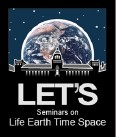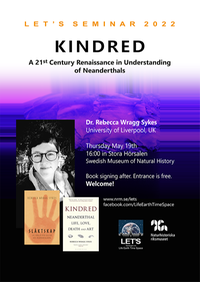LET'S Seminars
The Swedish Museum of Natural History is running a seminar series on issues of wide interest for natural history - on Life, Earth, Time and Space.
Upcoming presentations
Kindred: A 21st Century Renaissance in Understanding of Neanderthals
Presenter: archaeologist and author Dr. Rebecca Wragg Sykes.
Bio: Dr. Wragg Sykes is an archaeologist, author and Honorary Fellow at the University of Liverpool. She has a broad interest in the ancient world of the Paleolithic and especially in Neanderthal Archaeology. Her first book “Kindred: Neanderthal Life, Love, Death and Art” (also available in Swedish from Daedalos as “Släktskap: liv, kärlek och kultur hos neandertalarna”) is a critically acclaimed and award-winning bestseller, where she explores how 21st century science and archaeology have revolutionized how we view our ancient relatives.
Time: Thursday the 19th of May, 16.00–17.00.
Place: Stora hörsalen (next to the museum restaurant), Swedish Museum of Natural History, Frescativägen 40, Stockholm.

About the seminars
Topics may range from cosmology to conservation biology, with an emphasis on recent scientific advances and cross-discipline interactions.
Our aim is to present lectures that will communicate the excitement of modern science to a varied but scientifically informed audience of scientists, students and laymen.
There are a number of top-notch scientists giving lectures. The seminars are open to everyone interested. Entrance is free. The language is English (occasionally Swedish, as advertised).
We hope for lots of questions and discussions during and after the lectures, and there will be opportunity for an informal get-together after each lecture.
Follow us:
Previous seminars
2019-11-21 Dr. Katerina Douka, Max Planck Institute for the Science of Human History. The daughter of a Neanderthal and a Denisovan - How new fossil discoveries reshape palaeoanthropology.
2018-10-11 Professor Mark Thomas, University College London. Genetic Astrology: Debunking commercial genetic ancestry claim
2015-12-18 Professor Andrew H. Knoll, Harvard University. Earth and Life: A Dance through Time.
2015-11-17 Chris Stringer, Natural History Museum UK, and Mattias Jacobsson, Uppsala universitet.
The human journey: A palaeontological and genetic view on human evolution
2014-11-18 Sigurdur Gislason, Iceland University
Icelandic volcanoes and their environmental impact
2013-12-10 Greger Larson, Durham University
Domestication – where, when and how many times?
2012-05-22 Ronny Rößler The Museum of Natural History in Chemnitz Snapshot of an Early Permian Forest Ecosystem - The Petrified Forest of Chemnitz
2010-10-04 Tom McCarthy PANTHERA´s Snow Leopard Program
Snow Leopards – Saving a treasure of Central Asia´s Mountains
2008-11-04 David Catling University of Bristol
The rise of oxygen in Earth’s early atmosphere
2008-10-28 Peter Holland University of Oxford
The origin of vertebrates: A tale of genes, genomes and amphioxus
2008-10-21 John W.K. Harris Rutgers University
What chimpanzee and capuchin studies tell us about the behavior of the earliest hominids
2007-12-04 Lars Werdelin Swedish Museum of Natural History
The evolution of cats
2007-11-04 Erik W. Born Greenland Institute of Natural Resources
The fate of polar bears in a warming world
2007-10-18 Bertil Nordenstam Swedish Museum of Natural History
Linnés apostlar – resor, äventyr, samlingar
2008-10-14 Dan-Eric Nilsson Lunds universitet
Hur ser djur?
2007-10-09 Jonathan Shaw Duke University
Polyploidization and hybridization as evolutionary forces in Sphagnum (peat mosses)
2007-09-25 Michael J. Donoghue Yale University
Innovation and geographic movement as drivers of diversification: A case study from plants
2007-09-12 Jenny Beckman Uppsala University
Namn och natur – Linné, nomenklatur och historia
2007-05-15 Venki Ramakrishnan University of Cambridge
The Ribosome: The cell’s protein factory and how antibiotics inhibit it
2007-05-08 Eva Nyström Uppsala Universitet
Linnékorrespondensen – ett vetenskapligt nätverk från 1700-talet
2006-12-11 Per J. Palsbøll University of California, Berkeley
Speciation of minke whales during global warming
2006-09-27 Kevin J. Peterson Dartmouth College
MicroRNAs and metazoan evolution: insights into animal complexity and constraint
2006-06-09 Karl Kjer Rutgers University
The influence of methods and philosophy
2006-05-19 Peter & Rosemary Grant Princeton University
Evolution of Darwin’s finches
2006-04-24 Brian Rosen Natural History Museum, London
Corals and climate change: what can the fossil record tell us?
2006-03-21 Michael Foote University of Chicago
Origination and extinction in the history of life
2006-02-06 Jere H. Lipps University of California, Berkeley
Megaquakes and tsunamis: destruction, death and the microfossil record
2005-12-12 Susannah Porter University of California, Santa Barbara The early evolution and diversification of eukaryotes
2005-12-05 John Lundberg Academy of Natural Sciences, Philadelphia
Modernization of Neotropical freshwater fishes and their habitats
2005-11-21 Antonio Lazcano Universidad Nacional Autónoma de México
Fifty years (or more?) of prebiotic chemistry: from the Miller experiment to the primitive soup
2005-11-07 Bengt Gustafsson Uppsala universitet
Out of the dark ages of the Universe
2005-10-03 Penelope Boston New Mexico Institute of Mining and Technology
The Planet Within: Exploring cave habitats on Earth and beyond
2005-09-19 Joseph Scheer Alfred University
‘Mothing’
2005-09-09 James A. Doyle University of California, Davis
Ecology of the first angiosperms: evidence from paleobotany, molecular systematics, and ecophysiology
2005-05-19 John Hayes Woods Hole Oceanographic Institution
Life’s Cambrian Explosion: What lit the fuse?
2005-04-04 Jan van Dam Utrecht University
European micromammal communities and Neogene climatic change
2005-03-21 James Kasting Pennsylvania State University
Evolution of the Earth’s atmosphere and climate
2005-02-28 Richard A. Fortey Natural History Museum, London
Writing the intimate history of the Earth
2005-02-09 Juan Manuel García-Ruiz University of Granada
Desperately seeking life: Problems in the detection of primitive life remnants
2005-02-14 Peter K. Endress University of Zürich
Archaic living flowers
2005-01-31 Philip C.J. Donoghue University of Bristol
Gene duplication, extinction, and vertebrate evolution
2005-01-17 Per R. Flood Bathybiologica, Bergen
Appendicularia – the vacuum cleaners of the sea
2004-12-13 Darin Croft Case Western Reserve University
Armadillos, chinchillas, and ungulates: fossil mammals in the Chilean Andes
2004-11-29 Frode Ødegaard Norwegian Institute for Nature Research
Insect diversity in the tropics: A view from above ground
2004-09-20 Nicholas J. Butterfield University of Cambridge
Proterozoic plants, animals and fungi: reconciling early origins with delayed radiation
2004-09-16 Richard O. Prum Yale University
The development and evolution of feathers
2004-06-14 Jan Toporski Carnegie Institute of Washington
Astrobiology and the quest for evidence of life on Mars
2004-04-26 Per E. Ahlberg Uppsala University
Fossils, genes and four-legged fishes
2004-04-16 James H. Nebelsick University of Tübingen
What’s for dinner? – The history of predation
2004-03-29 Dolf Seilacher University of Tübingen and Yale University
Ediacara: The dawn of animal life – in the shadow of giant protozoans
2004-03-12 F. James Rohlf State University of New York
The relation between within-population covariance and evolution of shape in a lineage of stickleback fish – a geometric morphometric study
2004-02-27 Mikael Fortelius University of Helsinki
Using fossil mammals to map continental-scale rainfall patterns during 20 million years
2004-02-16 Lindell Bromham University of Sussex
Can we trust the molecular clock?
2003-12-08 Frances Westall Centre de Biophysique Moléculaire, CNRS, Orléans
Life on Earth 3500 million years ago: fact or fiction?
2003-12-01 Bernd R. Schöne J.W. Goethe University
How Bivalved Methuselahs help modeling climate – Long-term, high-resolution analyses on shells of the ocean quahog (Arctica islandica)
2003-11-24 Peter Crane Royal Botanic Gardens, Kew
Plant conservation biology at the Royal Botanic Gardens, Kew
2003-11-17 Donald E. Canfield University of Southern Denmark
Life and sulphur through time
2003-10-20 R. Robert Waller Canadian Museum of Nature, Ottawa
Risk assessment and conservation planning at the Canadian Museum of Nature
2003-10-06 Richard Mayden St Louis University
On individuation in the natural sciences, with emphasis on biological species and species concepts
2003-09-16 Jens Ormö Centro de Astrobiología (INTA/CSIC), Madrid
The Sirente crater field – implications for comparative planetology and human history
2003-05-23 Ján Veizer Ruhr-Universität Bochum and University of Ottawa
What drives the climate? A perspective from four billion years of carbon cycle
2003-05-05 Niels Peder Kristensen University of Copenhagen
‘Gladiator insects’ and their allies: The new order Mantophasmatodea
2003-04-14 Bruce Runnegar NASA Astrobiology Institute
Evolution of life on the early Earth: From obscurity to complexity
2003-03-31 Göran Pershagen Karolinska Institutet
Varför ökar allergierna – Lever vi för onaturligt?
2003-03-03 Paul Hanson Universidad de Costa Rica
Tropical Hymenoptera: The Costa Rican experience
2003-01-20 Detlev Arendt EMBL, Heidelberg
Evolution of gastrulation in the Bilateria
2002-12-09 Minik Rosing University of Copenhagen
The earliest life on Earth – and how it shaped our planet
2002-11-25 Stefan Bengtson Swedish Museum of Natural History
Early animal diversification – false starts, environmental hardships, and final success
2002-11-11 Herrick Baltscheffsky Stockholm University
The Great Anastrophe – the origin of life on Earth
2002-10-07 Anders Bárány The Nobel Museum
How do you get the Nobel Prize?
2002-09-23 Martin Brasier Oxford University
The origins of life: Turning up the heat
2002-06-03 David Cantrill Swedish Museum of Natural History
Antarctica’s fossil forests: What do they tell us about Southern Hemisphere biogeography?
2002-05-06 Bernt Walther University of Bergen
The enigma of sex: Do life’s dual roots reflect cellular evolution by primordial sex?
2002-04-29 Björn Sohlenius Naturhistoriska riksmuseet
Ordning eller slump? Vad bestämmer individrikedom och artantal hos smådjur i skogsmark?
2002-04-15 Mark Chase & Michael Fay Royal Botanic Gardens, Kew
New perspective on orchids: genetic studies alter our ideas about orchid evolution
2002-03-18 Mark D. Sutton University of Oxford
The worm that turned: liberating stone-locked animals with the use of digital wax
2002-03-04 Arne Öhman Karolinska institutet
Evolution and emotion: The case of phobias
2001-12-03 Paul F. Hoffman Harvard University
Snowball Earth: Testing the limits of global change
2001-11-19 Kåre Bremer Uppsala University
Dating flowering plant phylogenies
2001-11-13 René Liseau Stockholms observatorium
Darwin letar efter liv i rymden
2001-10-15 Graham Budd Uppsala University
Evolution’s missing link
2001-10-01 Claus Nielsen University of Copenhagen
The Articulata/Ecdysozoa controversy
2001-09-10 Olle Israelsson University of California, Berkeley
Xenoturbella (phylum uncertain): The appearance and disappearance of everything
2001-05-28 Philip J. Currie Royal Tyrrell Museum of Palaeontology, Alberta
New dinosaur discoveries
2001-05-21 Derek E.G. Briggs University of Bristol
Exceptional fossils – how soft-tissues are preserved
2001-05-14 Joseph L. Kirschvink California Institute of Technology
Martian magnetofossils and Panspermia
2001-04-09 16.00 Karl O. Stetter University of Regensburg
(Hyper) thermophiles in the history of life
2001-03-05 Martin Whitehouse Swedish Museum of Natural History
When was life established on Earth? – a review of evidence and current controversies
2001-02-19 Mark A. Purnell University of Leicester
Toothless hags and chinless wonders: Early vertebrate evolution and the importance of fish food
2000-12-04 Daniel R. Brooks
Evolution in the Information Age: Life has a life of its own
2000-10-16 Gerard Willemsen
Uttrar genom tiderna
2000-10-09 Nobuyuki Yamaguchi
The Barbary lion, its phylogeny and conservation
2000-09-13 James Lake
The evolution of the multicellular animals
2000-05-15 J. William Schopf
Solution to Darwin’s dilemma: Discovery of the missing Precambrian record of life
2000-04-10 Jens Böcher
Insects on top of the World - present and past
2000-03-20 Peter Westbroek
Let’s reclaim Gaia for science
2000-03-13 Frans Witte
Lessons on speciation and extinction from man’s impact on Lake Victoria
2000-02-28 Sherry L. Cady
Life in hot springs as a guide to fossil hunting on Mars
2000-02-07 Rachel Wood
Reefs through time
2000-01-24 Michael G. Bassett
Earth evolution seen through a museum exhibition
1999-12-06 André Adoutte
Reconstructing animal evolution: combined evidence from molecular phylogeny and HOX gene analysis
1999-11-22 Godfrey M. Hewitt
The colonization of Europe after the Ice Age
1999-11-08 Anders Tehler
Ribosomala sekvenser och svamparnas fylogeni
1999-10-16 John W. Daly
Thirty years of discovering arthropod alkaloids in amphibian skin
1999-10-11 Svante Pääbo
Molecular coproscopy - a window into the genetics and diet of Pleistocene mammals
1999-09-27 Stephen Williams
The role and future of natural history collections in modern society
1999-09-20 Olivier Rieppel
The aquatic origin of turtles
1999-05-31 Allen Joel Anderson
Gaia Theory and the Quantum Universe
1999-05-10 Ulf Jondelius
Searching for basal bilaterian clades
1999-04-19 Ann-Sofie Rasmussen
Vertebrate evolution - the story molecules tell
1999-03-15 Lars Falk
Patologisk vetenskap
1999-03-08 Andrew H. Knol
Life on a young planet: A geological perspective on early evolution
1999-02-22 Simon Conway Morris
The Cambrian explosion: Megatonnage or damp squib?
1999-02-15 Jared Diamond
Biological conservation in New Guinea, a treasurehouse of biodiversity
1999-02-08 Robert Ricklefs
Historical aspects of biodiversity
1999-01-25 Henry Gee
Origin of vertebrates - controversy and consensus




